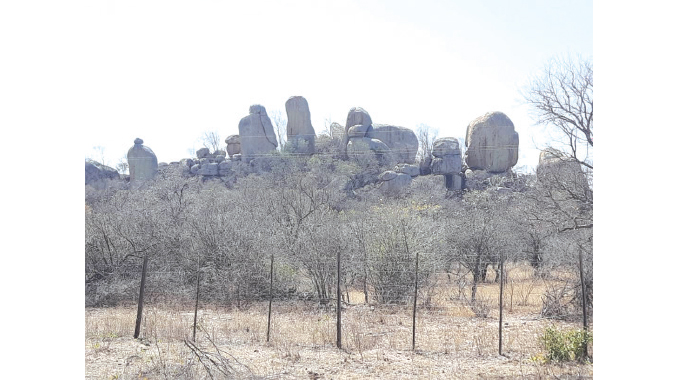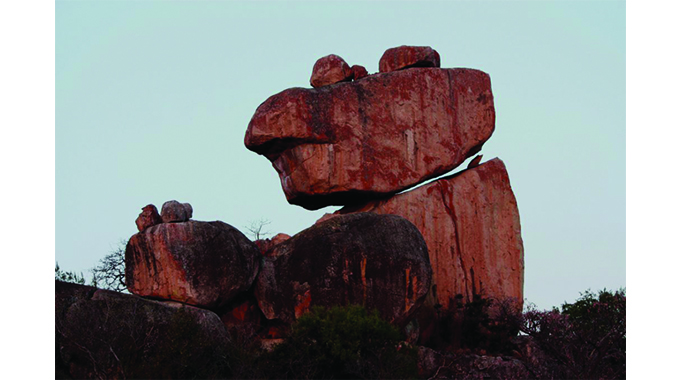Guyu-Manama Road balancing rocks, a sight to behold

Yoliswa Dube-Moyo, Features Editor
FOR the avid traveller, the picturesque balancing rocks lining the Guyu-Manama Road in Gwanda District are a sight to behold.
The imposing rocks are stacked on top of each other, some precariously, much to the awe of nature lovers.
They are a breath of fresh air from the nearby buzzing mining town of Gwanda.
Similar to the Matobo Hills, the hills in Gwanda South are granite rock, formed over millions of years, and have been weathered and carved by the elements to form numerous rock hills and narrow valleys.
The area exhibits extensive natural rock formations with large boulders and incredible balancing rocks and kopjes.
Some of the huge granite rocks have been shelter to the people that lived in the area.

Gogo Nkulumo Ncube
Evidence of human habitation is clear from the innumerable traces of their tools, art, houses and other structures.
Lebolahudo, one of the hills, was christened by locals after a curious baboon climbed up the mountain and failed to come down, resulting in its death atop one of the boulders.
Beyond the breathtaking hills lies a rich history of a community grounded on tradition and culture whose roots can be traced to the Jahunda-speaking people.
Chronicle Features recently caught up with Gogo Nkulumo Ncube at her home in Sibuze Village, Gwanda District to learn more about the hills and the heritage of the people in the area.
One of the most eminent hills, Mbigwe, close to Nsimbi Primary School, has become popular among tourists thanks to its cave with San paintings.
Gogo Ncube said over the years, scores of tourists and children on school trips have visited the mountain which is said to be holy.
“A lot of tourists visit this cave because of those paintings. Over the years, we’ve seen plenty of cars drive past enroute to the Mbigwe Hills,” she said
Spiritual rituals and pilgrimages by various churches are also done there almost every year.
“During this time of the year, until around October, people would gather to pray for rain. They would dance close to Ntambe River near the hill. They would carry all sorts of grain, traditional brew and meat that would be eaten there. Close to the day, the men would hunt for the meat that would be eaten by the multitudes who would go to the river,” said Gogo Ncube.
She said after the rituals, the dancing and the eating, the bones from the meat would be burnt and buried.
“I don’t know why they would burn the bones. In those days, we never used to ask such questions. We would just watch as the elders performed the rituals. The bones wouldn’t be left in the open, they would be burnt and buried,” said Gogo Ncube.
Sibuze Mountain, a stone’s throw away from Gogo Ncube’s house is said to have been inhabited by seers.
“People used to go there to seek guidance on a number of issues. The people who lived there were believed to possess prophetic powers so villagers flocked the mountain to receive revelations and guidance on the paths they wanted to take in life,” said Gogo Ncube.
She said there were makeshift shelters at the foot of the mountain where the seers lived while some of them lived in caves.
“When we used to go up those mountains as we were herding cattle, we would see makeshift shelters and ashes which were a sign that there were people living there. Now that I’m old and frail, I can no longer go up the mountains to see what’s happening there now,” said Gogo Ncube whose knees now fail her due to arthritis.

Matopo Hills Zimbabwe
She said the caves were also used as hiding places during the country’s protracted liberation struggle.
“People would hide from the whites in the caves. They would sleep there and only come out when it was safe. This could take days and during those periods, they wouldn’t have enough to eat or drink,” said Gogo Ncube.
At Gubare Mountain, a family had settled in the caves as a way of dissociating themselves from other villagers.
“We used to see them when we were growing up. We would go to the mountain in search of firewood and grass to thatch our homes,” said Gogo Ncube as she struggled to remember the name of the family that lived there.
When it finally returned to her, she said, “It was the Dzidzani family. Those are the people that lived up Gubare Mountain.”
“Idwala lamanina is where a lot of women were killed during the war. During that time, we would be busy cooking meals for our people who were fighting for us. We would run up and down these mountains with food to give them.”
She said in those days, it was scary falling pregnant because of the unavailability of reliable health care services. There were no guarantees that when the time came, there would be a midwife available to deliver the baby safely.
“There’s also Gwingwizi Mountain located right in the middle of some farms a distance from here. People used to hide there and Makungubo Mountain during the war,” said Gogo Ncube.
She said back in the day, there were not many homes around the area but the village has expanded exponentially over the years.
“In those days, it was easy to advise girls and encourage them to stay away from boys. A child was raised by the whole village and they would listen whenever they were reprimanded. Nowadays, it’s not as easy because when the young ones look at us in our old age, they liken us to witches,” said Gogo Ncube.
Yet, in those days, a culture so rich kept the small, close-knit communities grounded and united. — @Yolisswa








Comments